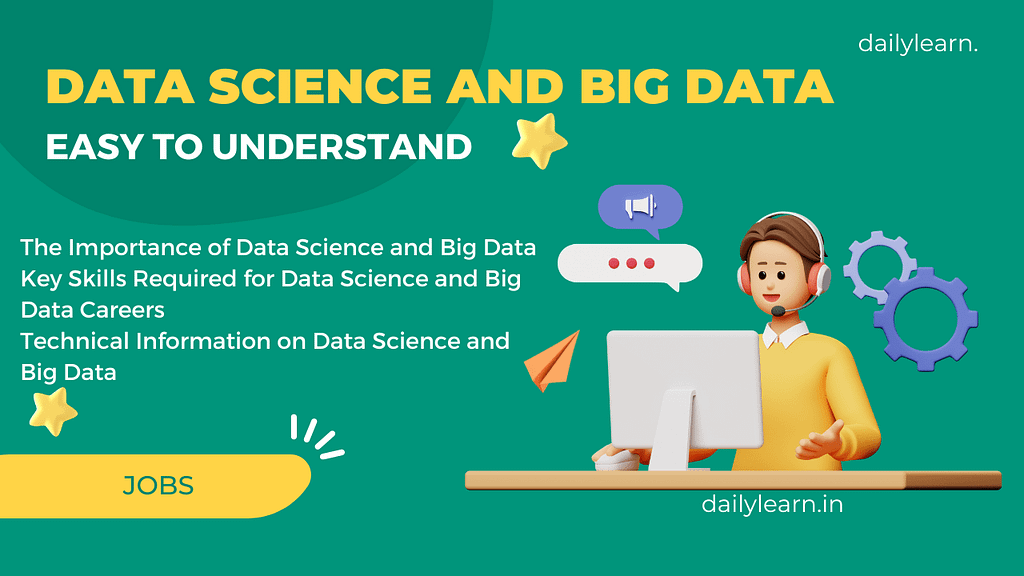Table of Contents
Introduction to Data Science and Big Data
In today’s digital age, data science and big data have become crucial components of how businesses operate and make decisions. With the exponential growth of data generated every day, these fields are essential for turning raw data into actionable insights. Data science involves using scientific methods, algorithms, and systems to analyze large amounts of data, while big data refers to the massive volume of data that traditional data-processing software can’t handle.
The importance of data science and big data cannot be overstated, as they play a vital role in predictive analytics, customer insights, and overall business strategy. This article will explore these concepts, the skills required to succeed in these fields, and the key technical aspects that drive them.
The Importance of Data Science and Big Data
Data science and big data are pivotal for several reasons:
Informed Decision-Making: By analyzing vast amounts of data, businesses can make decisions that are data-driven and backed by empirical evidence.
Predictive Analytics: Data science allows companies to predict future trends and behaviors, helping them stay ahead of the competition.
Customer Insights: Analyzing customer data helps businesses understand preferences and behaviors, leading to better-targeted marketing and product development.
Operational Efficiency: Data science optimizes processes by identifying inefficiencies and providing solutions based on data.
Click here to more knowledge from the Shiksha.
Key Skills Required for Data Science and Big Data Careers
To excel in data science and big data, professionals need a mix of technical and analytical skills, including:
Programming: Proficiency in languages such as Python, R, and SQL is essential for data manipulation and analysis.
Statistical Analysis: A deep understanding of statistical methods is crucial for interpreting data accurately.
Machine Learning: Knowledge of algorithms that enable computers to learn from data and make predictions is vital.
Data Visualization: The ability to present data findings through visual tools like Tableau or Power BI is important for communicating insights.
Big Data Technologies: Familiarity with tools like Hadoop, Spark, and NoSQL databases helps in managing and processing large datasets.
Technical Information on Data Science and Big Data
Data science and big data involve a variety of technical processes and tools designed to handle and analyze large datasets. Here are some of the key components:
1. Data Collection:
Data collection is the first step in the data science process. This involves gathering raw data from various sources, including:
Structured Data: Data that is organized in a specific format, such as databases and spreadsheets.
Unstructured Data: Data that is not organized in a pre-defined manner, such as text, images, and videos.
2. Data Cleaning:
Before analysis, data must be cleaned to remove inconsistencies, errors, and duplicates. This process ensures that the data is accurate and ready for analysis.
3. Data Analysis:
Data analysis involves applying statistical techniques and algorithms to discover patterns and relationships in the data. This can include:
Descriptive Analytics: Summarizing historical data to understand what has happened.
Predictive Analytics: Using historical data to predict future outcomes.
Prescriptive Analytics: Recommending actions based on data analysis.
4. Machine Learning and Artificial Intelligence:
Machine learning is a key component of data science that involves training models on data to make predictions or decisions without being explicitly programmed. Artificial intelligence (AI) takes this further by enabling machines to perform tasks that typically require human intelligence.
5. Data Visualization:
Data visualization is the process of presenting data in graphical formats such as charts, graphs, and dashboards. This helps stakeholders understand complex data insights easily.
6. Big Data Technologies:
Handling big data requires specialized technologies designed to manage, process, and analyze large volumes of data:
Hadoop: An open-source framework that allows for the distributed processing of large datasets across clusters of computers.
Spark: A fast and general-purpose cluster computing system for big data processing.
NoSQL Databases: Non-relational databases like MongoDB and Cassandra, which are designed to handle unstructured data.
Example Jobs in Data Science and Big Data
The demand for data science and big data professionals is growing rapidly, and there are several specialized roles within these fields:
Data Scientist: Responsible for analyzing complex data sets to uncover insights and inform business decisions.
Data Engineer: Focuses on building and maintaining data pipelines and architectures that allow data to be easily accessed and analyzed.
Machine Learning Engineer: Designs and implements machine learning models that can analyze data and make predictions.
Big Data Analyst: Specializes in analyzing large datasets to find patterns and trends that can be used for decision-making.
Business Intelligence Analyst: Translates data into actionable insights that help businesses improve their strategies and operations.
FAQs.
What is the difference between data science and big data?
Data science is a field that focuses on extracting insights from data using various techniques, while big data refers to the large volumes of data that cannot be processed by traditional means. Data science often uses big data to generate insights.
What programming languages should I learn for a career in data science?
The most commonly used programming languages in data science are Python, R, and SQL. Python is particularly popular due to its extensive libraries for data analysis and machine learning.
How is big data used in businesses today?
Big data is used in businesses for a variety of purposes, including customer segmentation, predictive analytics, risk management, and operational efficiency. Companies analyze big data to make informed decisions and stay competitive.
What tools are essential for working with big data?
Essential tools for working with big data include Hadoop for distributed data processing, Spark for fast computation, and NoSQL databases like MongoDB for handling unstructured data. Data visualization tools like Tableau and Power BI are also important.
How can I start a career in data science?
To start a career in data science, focus on building a strong foundation in mathematics, statistics, and programming. Obtain relevant certifications, such as those offered by Coursera or edX, and gain practical experience through projects and internships.
